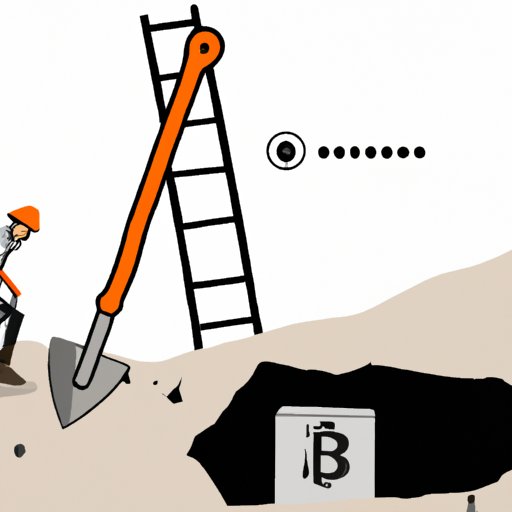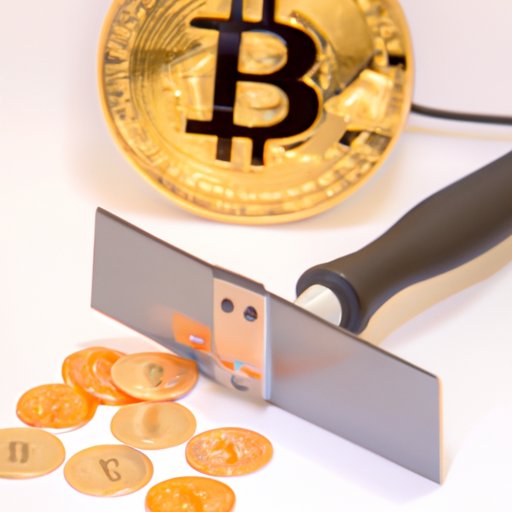Introduction
Bitcoin mining is the process of verifying cryptocurrency transactions and adding them to a blockchain. In essence, miners are rewarded for their work with cryptocurrency tokens. Bitcoin mining is an important part of the decentralized digital currency system, as it helps to ensure that all transactions are properly recorded and stored in a secure manner.
Exploring Bitcoin Mining: What is it and How Does it Work?
To understand better how Bitcoin mining works, it’s important to first look at the basics of Bitcoin mining. Bitcoin mining is the process of using computer hardware to solve complex mathematical problems in order to verify and record cryptocurrency transactions. The miners who take part in this process are rewarded with cryptocurrency tokens for their efforts.
There are two main types of Bitcoin mining: solo mining and pooled mining. Solo mining is the process of using a single computer to mine for Bitcoin. Pooled mining is the practice of joining a group of miners who work together, allowing each individual miner to increase their chances of earning rewards.
The rewards for successful Bitcoin mining can vary depending on the type of mining being done. Solo miners may receive a larger reward than those who join a pool. However, the amount of time and energy it takes to mine Bitcoins solo can be much more than when working in a pool. Additionally, miners may also receive transaction fees from other users who are sending Bitcoin.
A Beginner’s Guide to Bitcoin Mining: What You Need to Know
Before starting to mine for Bitcoin, it’s important to do some research into the cryptocurrency industry. Understanding the different types of hardware available and the associated costs can help you make an informed decision about which type of mining is right for you. Additionally, familiarizing yourself with the different software options available can help you set up your mining rig quickly and easily.
Choosing the right hardware is a crucial step in the process of setting up a mining rig. There are a variety of ASICs (Application-Specific Integrated Circuits) and GPUs (Graphics Processing Units) that can be used for mining. Each type of hardware has its own advantages and disadvantages, so it’s important to understand the differences between them before making a purchase. Additionally, selecting a power supply that is able to handle the power requirements of the mining rig is also essential.
Once the hardware has been selected, it’s time to set up the mining rig. This involves connecting all the components together, installing the necessary software, and configuring the settings to begin mining. Depending on the type of hardware being used, the setup process can vary. It’s important to follow the instructions provided by the manufacturer carefully to ensure the mining rig is set up correctly.
An Overview of Bitcoin Mining: Understanding the Process
In order to understand the process of Bitcoin mining, it’s important to first understand what the blockchain is. The blockchain is a distributed ledger that records every Bitcoin transaction. Miners use powerful computers to solve complex mathematical problems in order to add new blocks to the blockchain.
When a miner successfully solves a problem, they are rewarded with a certain number of Bitcoin. This process is known as “mining blocks”. As more miners join the network, the difficulty of solving these problems increases. This is why it is important for miners to have powerful hardware in order to remain competitive.

Bitcoin Mining 101: Breaking Down the Basics
Before beginning to mine for Bitcoin, it’s important to create a wallet. A wallet is a digital storage space that allows users to store their Bitcoin. Once the wallet has been created, miners can then join a mining pool. A mining pool is a group of miners who work together to increase their chances of earning rewards.
It’s important to understand the profitability of Bitcoin mining before investing in hardware and setting up a mining rig. Depending on the type of hardware being used and the cost of electricity, mining may or may not be profitable. Additionally, market fluctuations can have an effect on the profitability of mining operations.

The Ins and Outs of Bitcoin Mining: What You Should Know
There are two main types of mining: cloud mining and solo mining. Cloud mining is the process of renting mining hardware from a third-party provider. This allows miners to mine without having to purchase or maintain any hardware. Solo mining is the process of using an individual’s own hardware to mine for Bitcoin.
ASICs and GPUs are the two main types of hardware used for mining. ASICs are specialized chips designed specifically for mining, while GPUs are general-purpose processors commonly used for gaming and graphic design. Both types of hardware have their own advantages and disadvantages, so it’s important to consider which type is best for the individual miner.

Demystifying Bitcoin Mining: Uncovering the Details Behind the Process
In addition to understanding the technical aspects of mining, it’s also important to understand the legal and security considerations. As Bitcoin is decentralized, there is no central authority that can regulate miners. Therefore, it’s important to be aware of the laws in one’s country regarding cryptocurrency mining. Additionally, miners need to be aware of the security risks associated with mining, such as malicious actors attempting to steal funds or other valuable data.
Another factor to consider when mining for Bitcoin is the tax implications. Depending on one’s jurisdiction, miners may be subject to paying taxes on their rewards. Additionally, miners should also consider the environmental impact of their operations. Bitcoin mining requires a large amount of electricity, so miners need to be mindful of the carbon footprint of their operations.
Conclusion
Bitcoin mining is an important part of the decentralized digital currency system. By understanding the basics of Bitcoin mining, miners can start to earn rewards for their work. It’s important to research the different types of hardware available and the associated costs before investing in a mining rig. Additionally, miners should also be aware of the security considerations, tax implications, and environmental impact of Bitcoin mining.
(Note: Is this article not meeting your expectations? Do you have knowledge or insights to share? Unlock new opportunities and expand your reach by joining our authors team. Click Registration to join us and share your expertise with our readers.)
